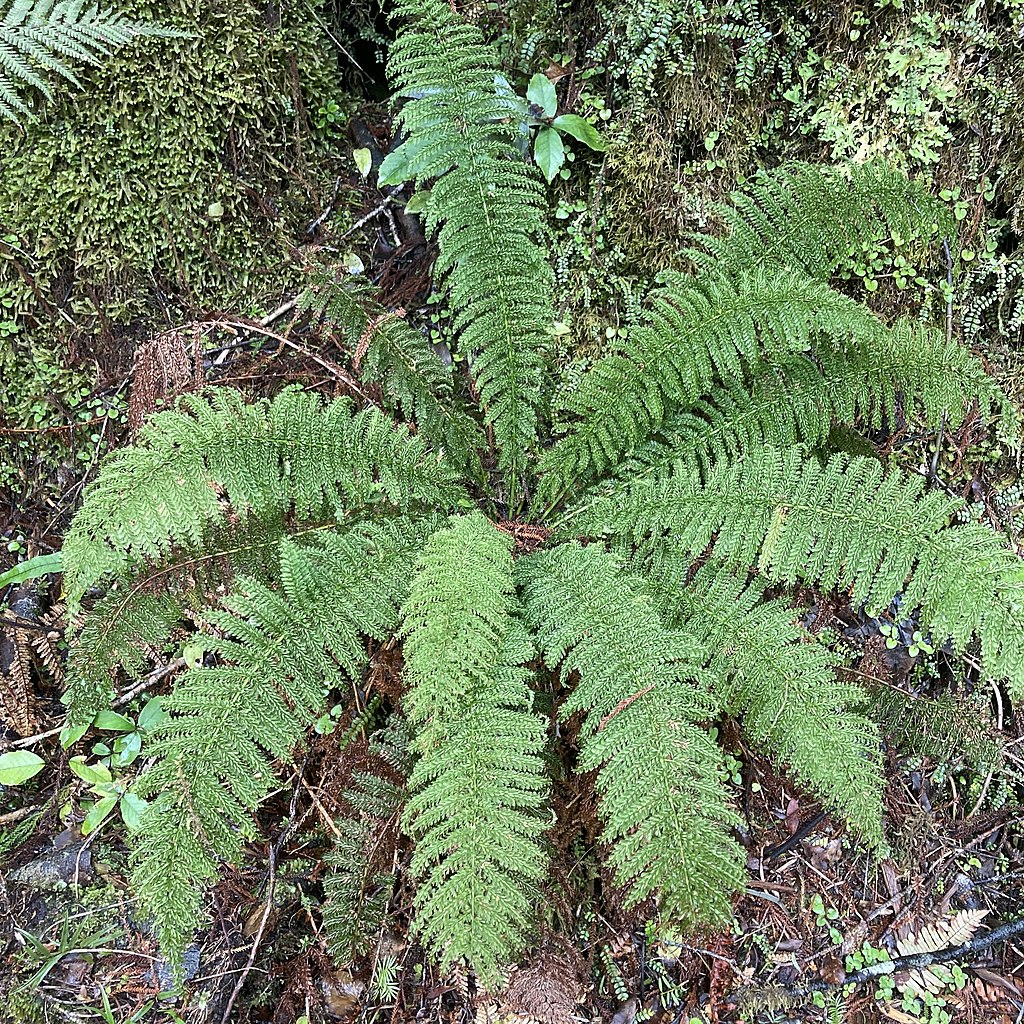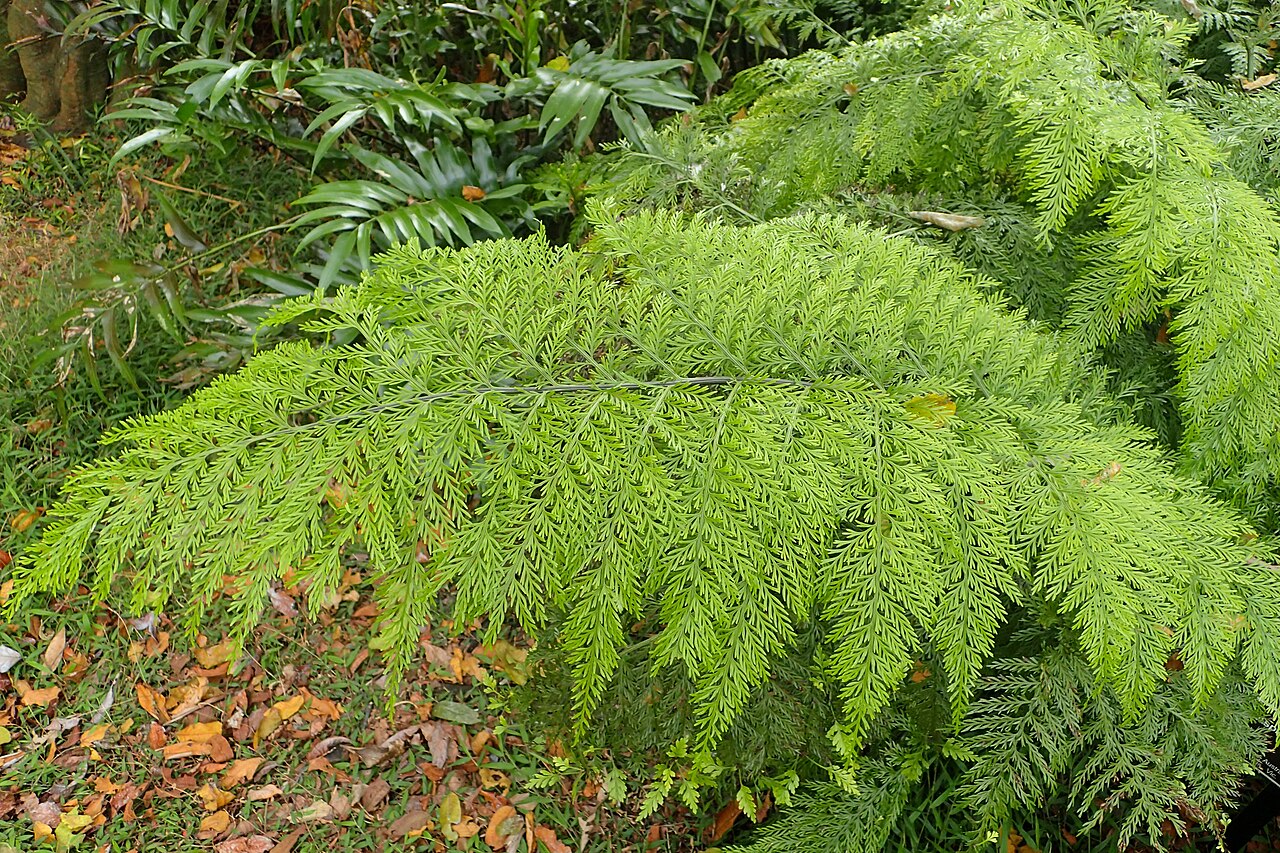Whekī (Rough Tree Fern)
Dicksonia squarrosa
Whekī (Dicksonia squarrosa) is a distinctive New Zealand tree fern known for its slender black trunk and crown of dark green fronds. This hardy fern is commonly found in lowland and lower montane forests throughout the country, often forming dense colonies. Its ability to tolerate light frost, moderate sun exposure, and various soil conditions makes it a versatile choice for gardens seeking to create a native forest atmosphere. The unique texture and form of Whekī contribute significantly to the character of New Zealand's forest understory.

Image credit: Wikipedia
Quick Facts
| Height | Up to 6 meters |
|---|---|
| Growth Rate | Fast (10-80cm per year) |
| Frond Length | 1.5-3 meters |
| Water Needs | Moderate to high |
| Light | Partial shade |
| Frost Tolerance | Moderate (protect below 4-5°C) |
| Soil Type | Well-draining, humus-rich |
Climate Best Suited To
Whekī is native to the forests of New Zealand, where it thrives in cool, moist, sheltered environments. It is found throughout the North Island and in the northern and western parts of the South Island. It prefers areas with consistent moisture, protection from strong winds, and moderate temperatures.
Regional Suitability
| City | Climate Suitability |
|---|---|
| Whangārei | Ideal |
| Auckland | Ideal |
| Hamilton | Ideal |
| Tauranga | Ideal |
| Rotorua | Ideal |
| Gisborne | Moderate |
| New Plymouth | Ideal |
| Napier | Moderate |
| Whanganui | Ideal |
| Palmerston North | Ideal |
| Wellington | Ideal |
| Nelson | Ideal |
| Christchurch | Moderate |
| Dunedin | Moderate |
| Invercargill | Challenging |
Growing Requirements
Soil Requirements
Whekī performs best in the following soil conditions:
- Rich, humus-filled soil
- Good moisture retention
- Well-draining but consistently damp
- Slightly acidic to neutral pH (5.5-7.0)
- Benefits from added leaf mold or composted pine needles
- Tolerates poor soils if moisture is adequate
Light Requirements
This tree fern prefers shaded conditions:
- Dappled to deep shade
- Protection from direct sunlight, especially midday sun
- Morning sun tolerated in cooler regions
- Ideal under canopy of taller trees
- Can tolerate more light if soil remains consistently moist
- Young plants need more shade than established specimens
Water Requirements
Whekī has moderate to high water needs:
- Regular watering, especially during establishment
- Keep soil consistently moist but not waterlogged
- Water both the crown and soil during dry periods
- Mulch to retain soil moisture
- Reduce watering slightly in winter
- Increased watering needed during hot, dry periods
Temperature Tolerance
Whekī has the following temperature preferences:
- Prefers moderate temperatures
- Ideal growing range: 10-25°C (50-77°F)
- Can tolerate light frosts once established
- Protect from severe frost in colder regions
- Avoid hot, dry conditions
- Provide extra humidity during hot periods
Wind Tolerance
Whekī has moderate wind tolerance:
- Prefers sheltered locations
- Protection from strong, drying winds
- Fronds can be damaged by persistent wind
- Plant in groups for mutual protection
- Use windbreaks in exposed gardens
- More wind-tolerant than many other tree ferns
Growth Habit
Understanding Whekī's growth habit:
- Slender, black trunk up to 7 meters tall
- Distinctive suckering habit, forming groves
- Crown of dark green, arching fronds
- Slow trunk growth (5-10 cm per year)
- Moderate frond production
- Persistent dead frond bases on trunk
Planting Guide
Site Selection
Choose a sheltered location with dappled shade and protection from strong winds. Whekī thrives under the canopy of taller trees or on the south or east side of buildings. Ensure the site has good air circulation but is not exposed to drying winds.
Soil Preparation
Prepare the soil by incorporating plenty of organic matter such as compost, leaf mold, or well-rotted manure. Ensure good drainage while maintaining moisture retention. For heavy clay soils, add grit or pumice to improve drainage.
Planting
Dig a hole twice as wide and as deep as the root ball. Position the tree fern so the crown is at or slightly above soil level. Backfill with prepared soil, firming gently. Water thoroughly after planting to settle the soil around the roots.
Mulching
Apply a 5-10 cm layer of organic mulch such as bark, leaf litter, or compost around the base, keeping it away from the trunk. This helps retain moisture, suppress weeds, and provide nutrients as it breaks down.
Watering
Water deeply immediately after planting. Keep the soil consistently moist for the first year. Water both the crown and the soil around the base. In dry periods, water more frequently, especially if fronds begin to droop.
Aftercare
Protect young plants from frost during the first few winters. Consider applying a balanced, slow-release fertilizer in spring. Remove damaged fronds as needed but allow old fronds to remain on the trunk as they provide protection and nutrients.
Spacing
If planting multiple specimens, space them 1-2 meters apart to allow for their suckering habit and eventual spread. This closer spacing mimics their natural growth pattern and creates a more naturalistic appearance.
Seasonal Care Calendar
Spring
- New fronds begin to emerge from the crown
- Apply a balanced, slow-release fertilizer
- Increase watering as growth resumes
- Remove any damaged fronds from winter
- Mulch to prepare for summer growth
- Good time to plant new specimens
Summer
- Water regularly, especially during dry periods
- Mist fronds during hot, dry weather
- Ensure mulch is maintained to conserve moisture
- Watch for pests and diseases
- Provide afternoon shade in hotter regions
- Avoid disturbing roots during this active growth period
Autumn
- Growth begins to slow
- Reduce fertilization
- Continue regular watering until rainfall increases
- Good time to divide and transplant suckers
- Apply fresh mulch before winter
- Prepare protection for young plants before frost
Winter
- Growth minimal or dormant
- Reduce watering but don't allow to completely dry out
- Protect from severe frosts in colder regions
- Avoid removing old fronds as they protect the crown
- Plan for spring divisions or new plantings
- Enjoy the evergreen structure in the winter garden
Propagation Methods
Division of Suckers
The most reliable method for home gardeners:
- Identify healthy suckers growing from the base of an established plant
- Wait until suckers are at least 30 cm tall with several fronds
- In autumn or early spring, carefully dig around the sucker
- Cut the connection to the parent plant with a sharp spade or saw
- Ensure the sucker has its own roots
- Replant immediately in prepared soil
- Water thoroughly and keep consistently moist until established
- Protect from direct sun and wind until new growth appears
Spores
For those wanting a challenge:
- Collect fertile fronds when spore cases turn brown (usually late summer)
- Place fronds on clean paper in a warm, dry place for 1-2 days
- Collect the fine, dust-like spores that fall onto the paper
- Prepare a sterile growing medium of peat and perlite
- Sprinkle spores thinly over the surface
- Cover with glass or plastic to maintain humidity
- Keep at 18-21°C (65-70°F) in indirect light
- Mist with distilled water to maintain moisture
- Prothalli will form in 1-3 months
- Young ferns will develop in 6-12 months
- Transplant when several fronds have formed
- Growth to mature size will take many years
Trunk Transplanting
For relocating mature specimens:
- Best done in autumn or early spring
- Trim fronds to reduce transpiration
- Dig around the trunk, preserving as many roots as possible
- Carefully lift the trunk and wrap roots in damp sacking
- Replant as soon as possible at the same depth
- Water crown and soil thoroughly
- Keep consistently moist until new growth appears
- Protect from wind and direct sun during establishment
Cultural History
Whekī has a significant place in New Zealand's natural and cultural heritage:
Traditional Māori Uses
- Known as "whekī" in te reo Māori
- Trunks used for building construction and fencing
- Durable black trunks resistant to rot when in contact with soil
- Young fronds (koru) occasionally eaten
- Trunk pith sometimes used as a food source in times of scarcity
- Used to mark boundaries and tracks through forests
Ecological Significance
- Important component of native forest understories
- Provides habitat for epiphytes and small invertebrates
- Contributes to forest biodiversity
- Helps prevent soil erosion on forest floors
- Suckering habit creates distinctive groves in natural settings
- Pioneer species in forest regeneration
European Settlement Impact
- Documented by early European botanists
- Habitat reduced through forest clearance
- Trunks used by settlers for fence posts and building
- Included in Victorian-era fern collections
- Specimens sent to European botanical gardens
Contemporary Significance
Today, Whekī is valued both for its ecological role in native forests and as an ornamental plant in gardens. Its distinctive black trunk and suckering habit make it a popular choice for creating naturalistic forest gardens. Conservation efforts include preserving its natural habitat in protected forest areas and using it in restoration projects to rebuild native forest understories.
Pests & Diseases
Common Pests
- Scale Insects: May appear on fronds as small bumps. Remove with cotton swab dipped in alcohol or use horticultural oil.
- Slugs and Snails: Often damage new fronds. Control with organic baits, copper tape, or beer traps.
- Caterpillars: Occasionally feed on fronds. Hand-pick or use organic Bacillus thuringiensis spray if infestation is severe.
- Possums: May damage fronds and crowns. Use possum guards or repellents in affected areas.
Common Diseases
- Crown Rot: Often results from water sitting in the crown. Ensure good drainage and air circulation.
- Fungal Leaf Spots: Various fungi can cause spotting on fronds. Improve air circulation and avoid overhead watering.
- Root Rot: Caused by overwatering or poor drainage. Ensure well-draining soil and avoid waterlogged conditions.
Environmental Issues
- Frost Damage: Severe frosts can damage fronds and crowns. Protect with frost cloth during cold snaps.
- Wind Damage: Strong winds can tatter fronds. Plant in sheltered locations or provide windbreaks.
- Drought Stress: Extended dry periods cause frond edges to brown. Increase watering and apply mulch.
- Sunburn: Direct sunlight causes yellowing and browning of fronds. Move to a more shaded location.
Whekī is generally resilient to pests and diseases when grown in appropriate conditions. Its tough nature makes it more resistant to problems than many other ferns. Good cultural practices including proper spacing, appropriate watering, and good air circulation will prevent most problems.
Bonus Tip
Create a dramatic night garden feature by uplighting Whekī trunks with low-voltage garden lights. The black, textured trunks create striking silhouettes when illuminated from below, while the undersides of the fronds catch the light to create a canopy effect. This not only showcases the distinctive architectural form of these tree ferns after dark but also adds depth and dimension to evening garden spaces. Use warm-toned lights for a natural effect, and position them to highlight the contrast between the dark trunks and feathery fronds.


